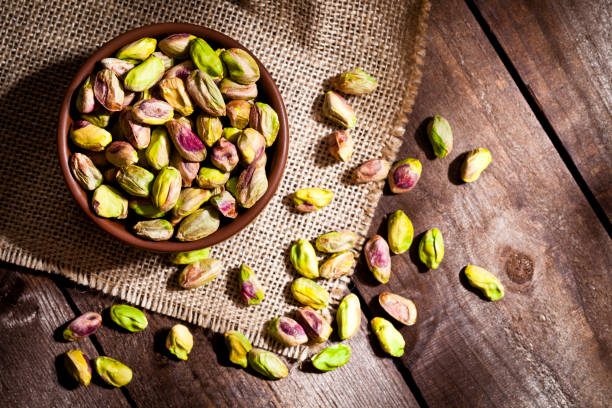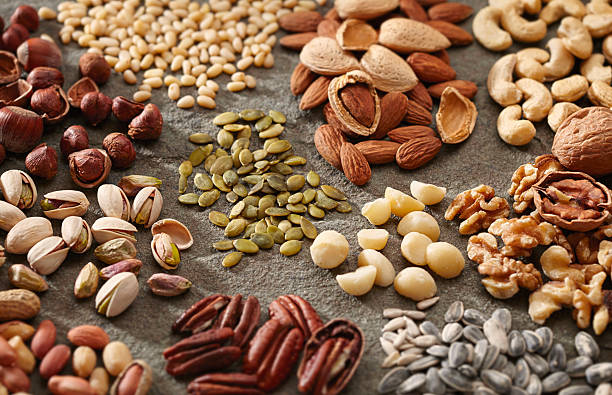Managing diabetes requires a well-balanced diet, and incorporating nuts and seeds for diabetes control can be a smart choice. These nutrient-dense foods provide a rich source of healthy fats, protein, and fiber, all of which play a crucial role in stabilizing blood sugar levels and supporting overall health.
However, not all nuts and seeds are created equal when it comes to diabetes management. Some varieties offer superior benefits, such as lowering blood sugar spikes, improving insulin sensitivity, and promoting heart health—a key concern for individuals with diabetes.
In this post, we’ll explore the best nuts and seeds for diabetes, explain their health benefits, and provide practical ways to include them in your daily meal plan for better blood sugar control and long-term wellness.

Why Nuts and Seeds Help with Diabetes
Incorporating nuts and seeds into a diabetes-friendly diet can offer powerful health benefits. These superfoods have a low glycemic index (GI), meaning they don’t cause rapid spikes in blood sugar levels. Instead, their rich fiber content helps slow down digestion, promoting more stable blood glucose levels throughout the day. This is essential for individuals managing type 1 and type 2 diabetes, as steady blood sugar levels can prevent energy crashes and reduce complications.
Beyond blood sugar control, nuts and seeds are packed with healthy fats, particularly monounsaturated and polyunsaturated fats, which support heart health. Since people with diabetes are at a higher risk of cardiovascular disease, eating heart-healthy foods like almonds, walnuts, chia seeds, and flaxseeds can be especially beneficial.
Additionally, scientific research suggests that regular consumption of nuts and seeds can enhance insulin sensitivity, aid in weight management, and reduce inflammation—all crucial factors in effective diabetes management. By including these nutrient-dense foods in your daily meals, you can take a natural and delicious step toward better health and long-term diabetes control.
Best Nuts for Diabetes Control
Including nuts in a diabetes-friendly diet can provide essential nutrients while helping to regulate blood sugar levels. Nuts are rich in fiber, protein, and healthy fats, making them an excellent snack option for individuals looking to manage diabetes naturally. Additionally, they have a low glycemic index (GI), meaning they won’t cause rapid blood sugar spikes. Here are some of the best nuts for diabetes control, along with simple ways to add them to your diet.
1. Almonds
Almonds are one of the best nuts for blood sugar control. They are high in fiber, protein, and heart-healthy monounsaturated fats, while being naturally low in carbohydrates. Research suggests that consuming almonds can lower fasting blood sugar levels, improve insulin sensitivity, and reduce post-meal glucose spikes. Plus, they provide magnesium, a key mineral that supports insulin function.
How to Eat Almonds:
✔ Snack on a handful of raw or roasted unsalted almonds.
✔ Add sliced almonds to oatmeal, yogurt, or smoothies for extra crunch.
✔ Use almond flour in baking as a low-carb alternative to regular flour.
2. Walnuts
Walnuts are packed with omega-3 fatty acids, which support heart health—a major concern for people with diabetes. These healthy fats help reduce inflammation, improve cholesterol levels, and promote better blood sugar regulation. Additionally, walnuts are rich in antioxidants that combat oxidative stress, which is often elevated in diabetes.
How to Eat Walnuts:
✔ Sprinkle chopped walnuts on salads for extra crunch and nutrition.
✔ Blend them into smoothies for a creamy texture and healthy fats.
✔ Enjoy a small handful as a quick, satisfying snack.
3. Pistachios
Pistachios are a diabetes-friendly nut known for their ability to help lower blood sugar levels after meals. They are also lower in calories compared to other nuts, making them ideal for weight management—a key aspect of diabetes control. Studies suggest that eating pistachios may reduce insulin resistance and improve heart health markers.
How to Eat Pistachios:
✔ Enjoy a small serving of unsalted pistachios as a snack.
✔ Add them to homemade trail mix with dried fruit and dark chocolate.
✔ Sprinkle chopped pistachios on roasted vegetables or whole-grain dishes.

4. Pecans
Pecans are rich in monounsaturated fats and antioxidants, which can help stabilize blood sugar levels and lower LDL (bad) cholesterol. They also contain polyphenols, plant compounds that support better insulin function and reduce inflammation in the body. Their naturally sweet and buttery taste makes them a delicious and healthy addition to a diabetes diet.
How to Eat Pecans:
✔ Eat a handful of raw or roasted pecans as a nutritious snack.
✔ Use crushed pecans as a topping for roasted vegetables or yogurt.
✔ Add them to whole-grain pancakes, waffles, or baked goods.
5. Brazil Nuts
Brazil nuts are one of the best sources of selenium, a powerful antioxidant that supports immune function, thyroid health, and glucose metabolism. Since people with diabetes are at a higher risk of inflammation-related complications, consuming selenium-rich foods like Brazil nuts may offer protective benefits. However, it’s important to eat them in moderation, as excessive selenium intake can be harmful.
How to Eat Brazil Nuts:
✔ Eat just one or two Brazil nuts per day to meet your selenium needs.
✔ Chop them into homemade granola or cereal for added crunch.
✔ Blend them into nut butter for a unique, nutrient-dense spread.
Best Seeds for Diabetes Control
Adding seeds to a diabetes-friendly diet is a simple yet effective way to support blood sugar regulation, heart health, and overall wellness. Seeds are packed with fiber, protein, and essential nutrients that help stabilize blood glucose levels, reduce inflammation, and improve insulin sensitivity. Below are some of the best seeds for diabetes control, along with easy ways to incorporate them into your meals.
1. Chia Seeds
Chia seeds are a powerhouse of fiber and omega-3 fatty acids, both of which are essential for blood sugar stability. Their high fiber content helps slow digestion, preventing rapid spikes in glucose levels after meals. Additionally, chia seeds absorb water and expand in the stomach, promoting a feeling of fullness and aiding in weight management—a key factor in diabetes control.
How to Eat Chia Seeds:
✔ Stir chia seeds into yogurt, oatmeal, or overnight oats for extra fiber.
✔ Make chia pudding by soaking them in almond milk with fresh fruit.
✔ Add them to smoothies to boost texture and nutritional value.
2. Flaxseeds
Flaxseeds are rich in fiber, lignans, and omega-3 fatty acids, making them one of the best seeds for diabetes management and heart health. Studies show that flaxseeds can help reduce blood sugar levels, lower cholesterol, and fight inflammation, all of which are beneficial for individuals with diabetes. However, whole flaxseeds can pass through the digestive system undigested, so it’s best to consume them in ground form.
How to Eat Flaxseeds:
✔ Use ground flaxseeds instead of whole seeds for better nutrient absorption.
✔ Sprinkle ground flax on cereals, yogurt, or smoothie bowls.
✔ Incorporate flaxseed meal into baked goods like muffins or pancakes.
3. Pumpkin Seeds
Pumpkin seeds, also known as pepitas, are an excellent source of magnesium, a mineral that plays a crucial role in regulating blood sugar levels and improving insulin function. They are also packed with healthy fats, protein, and antioxidants, making them a great snack for people with diabetes.
How to Eat Pumpkin Seeds:
✔ Eat roasted pumpkin seeds as a crunchy, satisfying snack.
✔ Add them to salads, soups, or grain bowls for extra nutrition.
✔ Blend them into homemade nut butter for a creamy spread.

4. Sunflower Seeds
Sunflower seeds are a great source of vitamin E, magnesium, and healthy fats, all of which support blood sugar control and reduce inflammation. Their high antioxidant content also helps protect against diabetes-related complications. To maximize their health benefits, opt for unsalted, raw, or dry-roasted sunflower seeds.
How to Eat Sunflower Seeds:
✔ Eat a handful of unsalted sunflower seeds as a snack.
✔ Sprinkle them on salads, soups, or stir-fries for added crunch.
✔ Use sunflower seed butter as a nutritious alternative to peanut butter.
5. Sesame Seeds
Sesame seeds are small but mighty when it comes to blood sugar regulation and heart health. They are rich in fiber, protein, and healthy fats, which help slow the absorption of carbohydrates and prevent blood sugar spikes. Additionally, tahini (a paste made from sesame seeds) is a great way to enjoy their benefits in a creamy, versatile form.
How to Eat Sesame Seeds:
✔ Sprinkle sesame seeds over roasted vegetables or whole-grain dishes.
✔ Use tahini in dressings, dips, or homemade hummus.
✔ Add them to whole-grain toast with avocado for a nutritious breakfast.
Tips for Adding Nuts and Seeds to Your Diet
Incorporating nuts and seeds into a diabetes-friendly diet can be a great way to boost nutrition, support blood sugar control, and promote heart health. However, since they are calorie-dense, it’s important to enjoy them in moderation and in their healthiest forms. Here are some key tips to help you make the most of these nutrient-packed superfoods:
1. Watch Portion Sizes
Nuts and seeds are highly nutritious, but they are also calorie-dense, meaning it’s easy to overeat them. To prevent excess calorie intake while still enjoying their benefits, stick to recommended portion sizes:
✔ Eat about a small handful of nuts (1 ounce) per day.
✔ Consume up to two tablespoons of seeds daily.
✔ Pre-portion your servings to avoid mindless snacking.
2. Choose Raw or Unsalted Varieties
Many store-bought nuts and seeds contain added salt, sugar, or unhealthy oils, which can negatively impact blood pressure and blood sugar levels. Instead, opt for raw, unsalted, or dry-roasted nuts and seeds for maximum health benefits.
✔ Look for unsweetened nut butters (like almond or sunflower seed butter) with minimal ingredients.
✔ Check nutrition labels to avoid added sugars or hydrogenated oils.
3. Pair with Protein or Fiber for Blood Sugar Control
Combining nuts and seeds with high-fiber or protein-rich foods can help slow digestion, reduce blood sugar spikes, and keep you full longer. This is especially beneficial for those managing type 2 diabetes or insulin resistance.
✔ Add nuts and seeds to oatmeal, whole-grain toast, or Greek yogurt.
✔ Pair nut butters with vegetable sticks like celery or cucumber for a balanced snack.
✔ Mix ground flaxseeds or chia seeds into smoothies, soups, or baked goods for an extra fiber boost.
4. Get Creative with Different Ways to Eat Them
There are endless ways to incorporate nuts and seeds into your daily meals, making it easy to enjoy their benefits without getting bored.
✔ Use nut butters as a spread on whole-grain crackers or toast.
✔ Blend ground seeds like flax or chia into smoothies for extra fiber.
✔ Sprinkle chopped nuts over salads, roasted vegetables, or yogurt.
✔ Bake with almond flour or flaxseed meal for a low-carb alternative to regular flour.
Conclusion: How Nuts and Seeds Can Support Diabetes Management
Incorporating nuts and seeds into a diabetes-friendly diet can be a simple yet effective way to support blood sugar control, heart health, and overall well-being. These nutrient-dense superfoods are rich in fiber, healthy fats, protein, and essential vitamins and minerals, making them an excellent choice for stabilizing blood sugar levels and reducing inflammation.
Among the best options, almonds, walnuts, pistachios, and pecans stand out as excellent nuts for diabetes management, while chia, flax, pumpkin, and sunflower seeds provide essential nutrients that aid in insulin sensitivity and digestion. By adding these foods to your meals and snacks in moderation, you can experience their many health benefits without unnecessary blood sugar spikes.
Making small, consistent changes to your diet can lead to long-term improvements in diabetes control. Whether you sprinkle chia seeds on yogurt, snack on a handful of walnuts, or blend flaxseeds into your smoothies, these simple additions can make a significant difference in your daily blood sugar management and overall health.
💬 Looking for more meal ideas or diabetes-friendly snack options? Let us know in the comments, and we’ll share more expert tips to help you on your journey to better health! 🚀

